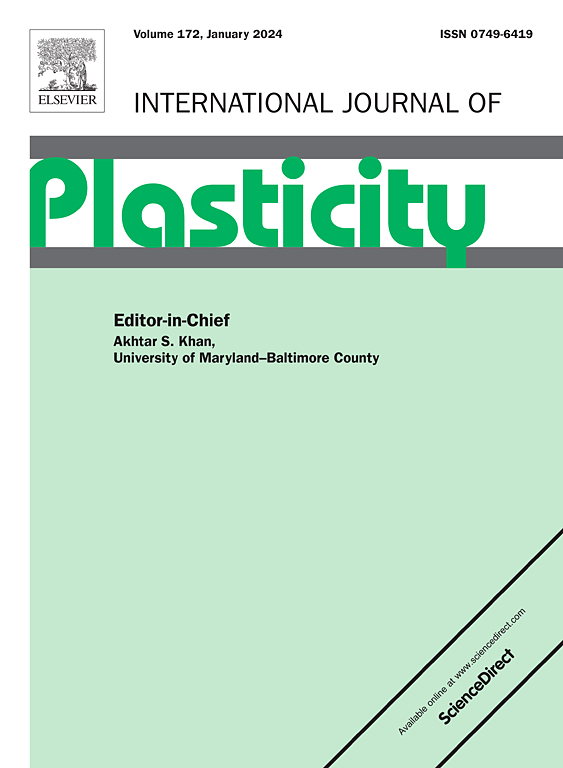Strain gradient-induced size effect of Nickel-Titanium shape memory alloys
IF 12.8
1区 材料科学
Q1 ENGINEERING, MECHANICAL
引用次数: 0
Abstract
This study investigates size effect in nickel-titanium (NiTi) shape memory alloys (SMAs), focusing on their elastic deformation and phase transformation behaviors. A series of experiments, including bulk-scale tension tests, micro-scale tension, compression, and cantilever bending tests, were conducted to observe the effect of specimen dimensions on SMA behavior. Micro-scale tension and compression tests unveiled a notable asymmetry in the phase transformation stress, irrespective of specimen dimensions. Moreover, micro-cantilever bending tests, spanning a thickness range from to , revealed a significant increase in both the effective elastic modulus and phase transformation stress as the beam thickness decreased. A constitutive model has been developed to address the tension/compression asymmetry and size effect based on couple stress theory, and implemented in finite element analysis of beam structures. Finally, experimental results were compared with simulation outcomes, and the deformation mechanisms responsible for size effect were discussed. The growing prominence of SMAs in micro/nano-scale applications highlights the necessity of understanding and accounting for size effect. Therefore, developing the capability to measure and simulate size effect is crucial for ensuring the effective utilization of SMAs in these scales.
应变梯度诱导的镍钛形状记忆合金尺寸效应
本文研究了镍钛形状记忆合金(NiTi)的尺寸效应,重点研究了其弹性变形和相变行为。通过体尺度拉伸试验、微尺度拉伸试验、压缩试验和悬臂弯曲试验,观察了试件尺寸对SMA行为的影响。微尺度拉伸和压缩试验揭示了应力诱导相变的显著不对称性,与试样尺寸无关。在厚度为1.9 ~ 21.0μm的微悬臂弯曲试验中,随着梁厚的减小,有效弹性模量和相变应力均显著增大。基于耦合应力理论,建立了解决梁结构拉压不对称和尺寸效应的本构模型,并将其应用于梁结构的有限元分析。最后,将实验结果与模拟结果进行了对比,探讨了尺寸效应的变形机制。sma在微/纳米级应用中的日益突出突出了理解和考虑尺寸效应的必要性。因此,发展测量和模拟规模效应的能力对于确保在这些规模中有效利用sma至关重要。
本文章由计算机程序翻译,如有差异,请以英文原文为准。
求助全文
约1分钟内获得全文
求助全文
来源期刊

International Journal of Plasticity
工程技术-材料科学:综合
CiteScore
15.30
自引率
26.50%
发文量
256
审稿时长
46 days
期刊介绍:
International Journal of Plasticity aims to present original research encompassing all facets of plastic deformation, damage, and fracture behavior in both isotropic and anisotropic solids. This includes exploring the thermodynamics of plasticity and fracture, continuum theory, and macroscopic as well as microscopic phenomena.
Topics of interest span the plastic behavior of single crystals and polycrystalline metals, ceramics, rocks, soils, composites, nanocrystalline and microelectronics materials, shape memory alloys, ferroelectric ceramics, thin films, and polymers. Additionally, the journal covers plasticity aspects of failure and fracture mechanics. Contributions involving significant experimental, numerical, or theoretical advancements that enhance the understanding of the plastic behavior of solids are particularly valued. Papers addressing the modeling of finite nonlinear elastic deformation, bearing similarities to the modeling of plastic deformation, are also welcomed.
 求助内容:
求助内容: 应助结果提醒方式:
应助结果提醒方式:


